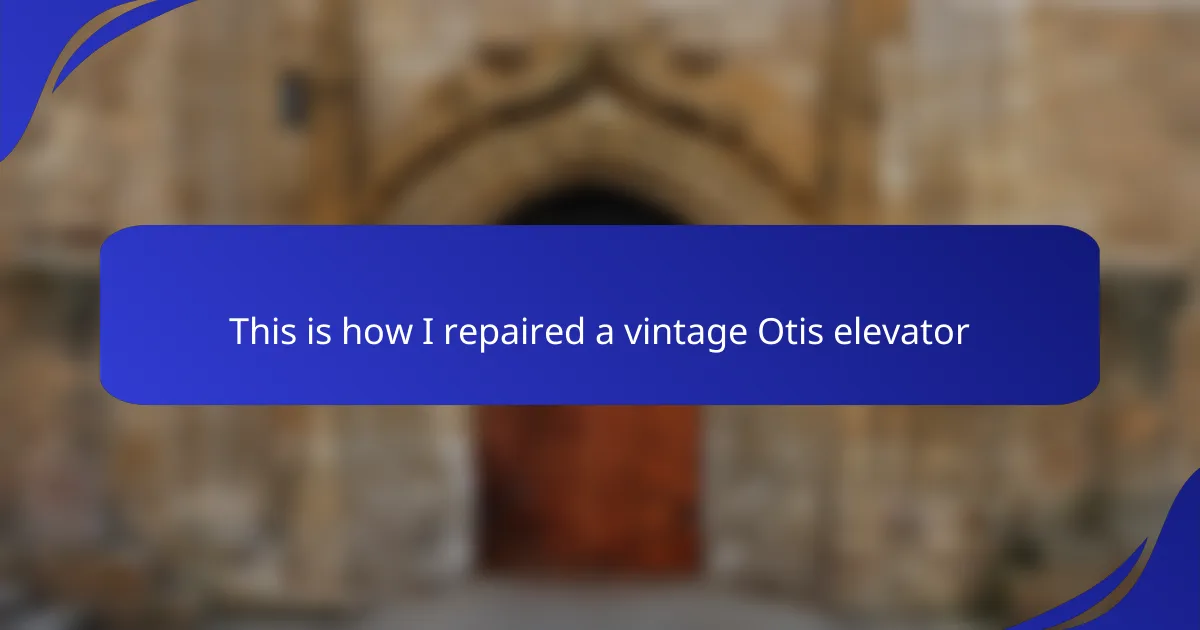Key takeaways
- The elevator industry has significantly evolved from simple hoisting systems in ancient times to advanced technologies prioritizing safety and sustainability.
- Key innovations, such as Otis’s safety brake and electric elevators, have revolutionized urban architecture and enabled the construction of skyscrapers.
- Vintage elevators possess unique charm and craftsmanship, presenting challenges in repair and maintenance that require specialized knowledge and patience.
- Restoration efforts not only preserve functionality but also honor the historical significance and stories behind these architectural artifacts.

Elevator Industry Overview
The elevator industry has a rich history that dates back to ancient times when simple hoisting systems were used. I often reflect on how far we’ve come since those early days, especially when I think about the innovation brought by manufacturers like Otis. Their contributions have transformed the way we navigate vertical spaces, making buildings accessible to everyone.
As I delve deeper into the journey of the elevator, I’m reminded of how it revolutionized urban architecture. Can you imagine a city skyline without towering skyscrapers? Elevators made it possible for buildings to soar to new heights, quite literally changing our perspective on architecture and urban living.
In today’s world, elevators are equipped with advanced technology, enhancing both safety and efficiency. I find it fascinating to see how modern systems prioritize energy conservation and user experience, reflecting our growing awareness of sustainability. The evolution of this industry is not just about mechanics; it’s about how technology can improve our daily lives.

History of Elevator Technology
Elevator technology has a rich history that dates back to ancient times, where simple pulleys were used to lift goods. I’ve always found it fascinating how these early innovations laid the groundwork for today’s advanced systems. When I think about the craftsmanship behind a vintage Otis elevator, I’m transported to a time when engineering was both an art and a science, marrying functionality with elegance.
As elevators evolved, pivotal moments defined their development. I remember admiring the intricate mechanical design of the Otis elevators at a historic building, marveling at their ability to transport not just people, but entire eras. The emotional connection I felt to the craftsmanship reminded me of our responsibility to preserve such pieces of history.
- The first recorded elevator was in 236 BC, designed by Archimedes using a simple pulley system.
- In 1853, Elisha Otis invented the safety elevator, drastically improving urban building designs.
- By the early 20th century, electric elevators became increasingly popular, revolutionizing skyscraper construction.
- Vintage lifts often feature ornate details, reflecting the architectural style of their time, making them historical artifacts.

Key Innovations in Elevators
When I first delved into the world of elevator repair, one of the most fascinating aspects was the key innovations that have shaped the elevator industry. For instance, the introduction of the electric elevator in the late 19th century was a game changer. I remember feeling a sense of awe when I learned about Elisha Otis’s safety brake mechanism, which made high-rise buildings possible and paved the way for urban development.
Another significant innovation I’ve come across is the modernization of hydraulic systems. While working on the vintage Otis elevator, I could see how these advancements improved efficiency and reliability. It’s reminders like these that truly highlight the blend of engineering and creativity that defines our industry.
Here’s a comparison table of some key innovations in elevator technology:
| Innovation | Impact |
|---|---|
| Safety Brake (Otis, 1853) | Enabled safe operation of elevators, paving the way for skyscrapers. |
| Electric Elevators (1880s) | Allowed faster travel and higher building designs. |
| Hydraulic Elevators (1854) | Revolutionized low-rise buildings with smooth and effective lifting. |

Understanding Vintage Elevators
Vintage elevators have a charm that modern ones often lack. I remember the first time I stepped into an Otis elevator built in the early 1900s. The scent of polished wood and the sound of the mechanical gears brought a wave of nostalgia. Each element reflects a craftsmanship that resonates with history and character, making every ride an experience.
Repairing these vintage systems can be a labor of love. For a while, I felt overwhelmed by the age and complexity, but as I delved into the intricacies, I found joy in preserving their legacy. Each part tells a story, reminding us of the innovations that shaped our cities. The challenge of restoring these elevators not only serves practical needs but also connects us to a bygone era.
Below is a comparison of vintage and modern elevators:
| Feature | Vintage Elevators | Modern Elevators |
|---|---|---|
| Design | Classic, ornate designs | Simplistic, functional designs |
| Technology | Mechanical, hydraulic | Smart, automated systems |
| Sound | Distinctive mechanical sounds | Quiet operation |
| Maintenance | Requires specialized knowledge | More standardized procedures |

Challenges in Repairing Elevators
Navigating the challenges of repairing elevators is like piecing together a fascinating puzzle. One hurdle I often encounter is sourcing authentic parts for vintage units. When I was restoring an Otis elevator, I spent hours scouring salvage yards and networking with other enthusiasts. It’s interesting how a seemingly simple repair can lead to a deep dive into history and craftsmanship.
I’ve also faced the intricacies of older technologies that don’t align with modern standards. There was a moment during my restoration project when I realized that the vintage wiring could be a safety concern. It forced me to think creatively about how to maintain the elevator’s original charm while ensuring it met today’s safety regulations. Have you ever felt torn between honoring the past and embracing progress?
Beyond technical issues, the emotional connection to these elevators adds another layer of complexity. Each repair session becomes a walk through history, evoking memories of its original grandeur. I often find myself pondering: what stories could these elevators tell if they could speak? This emotional investment can make the process both rewarding and, at times, overwhelming, as I strive to preserve their legacy.

My Experience with Otis Elevators
When I first encountered a vintage Otis elevator, it felt like stepping back in time. The craftsmanship was remarkable, showing the dedication that went into those early designs. As I worked to repair the elevator, I was filled with a sense of connection to the past, appreciating how these machines have played such a crucial role in urban development.
During my repairs, I noticed the intricate mechanisms and learned just how innovative Otis elevators were for their time. It was fascinating to see how these elevators were designed with safety and efficiency in mind, merging engineering with a touch of elegance. Every rusted bolt I replaced told a story, and with each success, I felt a surge of pride and accomplishment.
| Feature | Vintage Otis Elevator |
|---|---|
| Design | Classic craftsmanship with ornate details |
| Safety Mechanisms | Advanced for its time, including the safety brake |
| Efficiency | Dependable operation with simple mechanical systems |

Tips for Repairing Vintage Elevators
Keeping vintage elevators in good condition can be quite the undertaking, but I’ve learned a few tips along the way that make a real difference. One of the first things I recommend is to familiarize yourself with the specific model. For instance, when I was repairing an Otis elevator, I invested time in researching its mechanics and assembly. This not only eased the repair process but also deepened my appreciation for the craftsmanship behind the machine.
Another crucial aspect is sourcing replacement parts. I remember scouring through vintage parts warehouses, feeling like a treasure hunter. It’s surprisingly rewarding to find the exact piece you need. Building relationships with other restoration enthusiasts can also help—you never know who might have that elusive component stashed away.
Lastly, I cannot stress enough the importance of patience. Repairing a vintage elevator isn’t just about fixing it; it’s about honoring its story. There were moments during my repairs when I felt frustrated by the complexities of older technology. But in those instances, I took a step back, reminded myself of the beauty in preservation, and allowed myself to enjoy the journey. Have you ever found that slowing down helps you see things from a new perspective?



